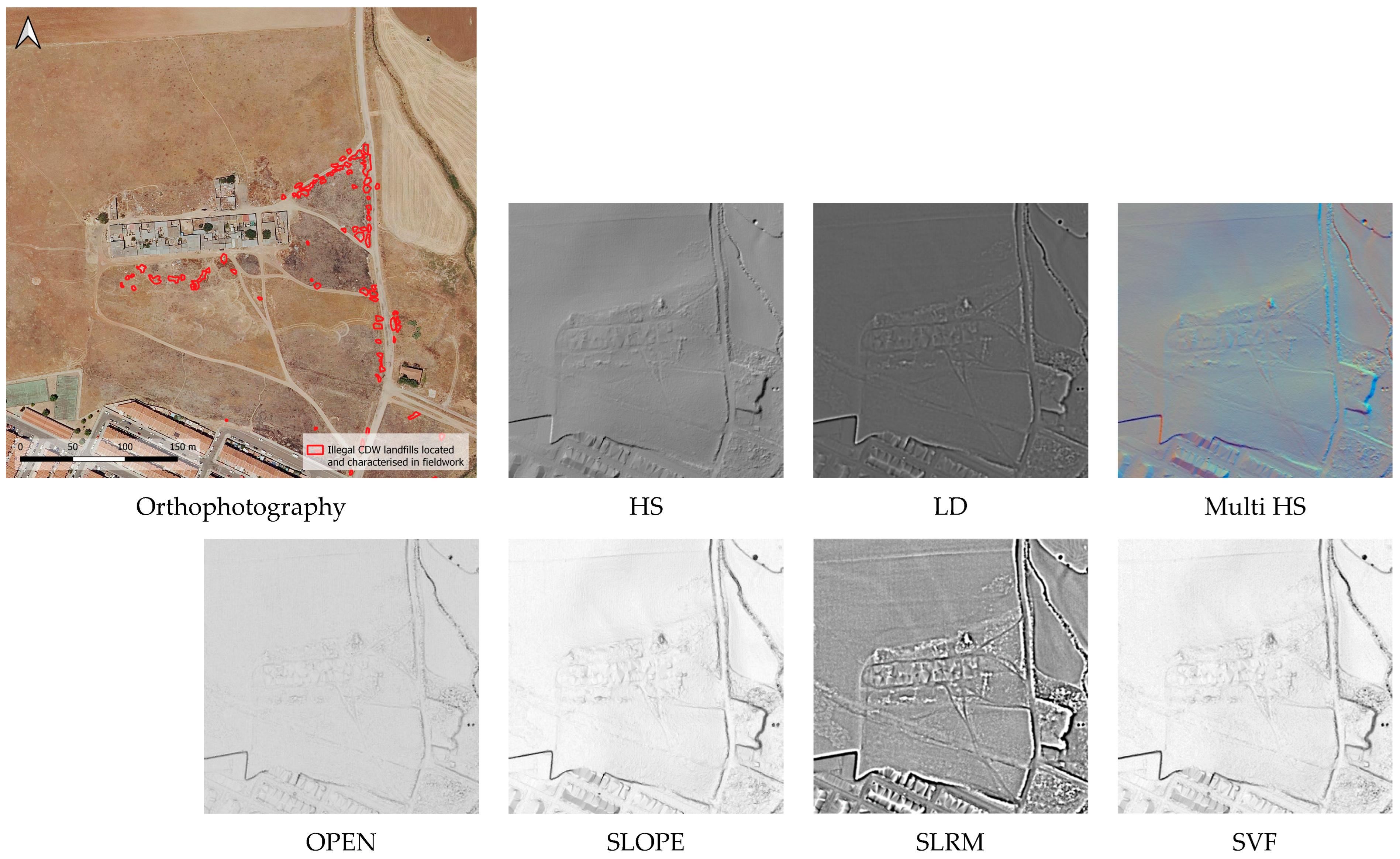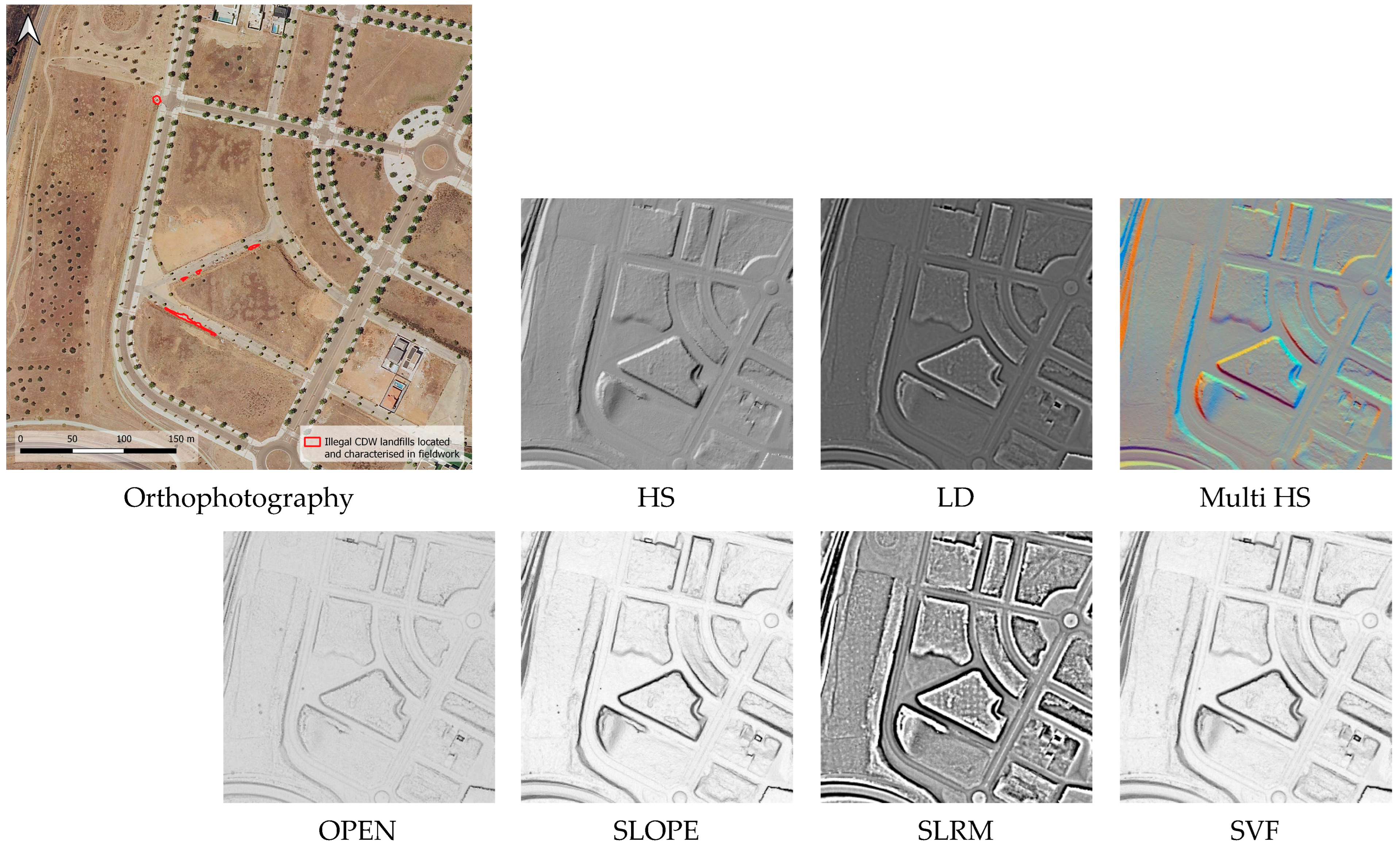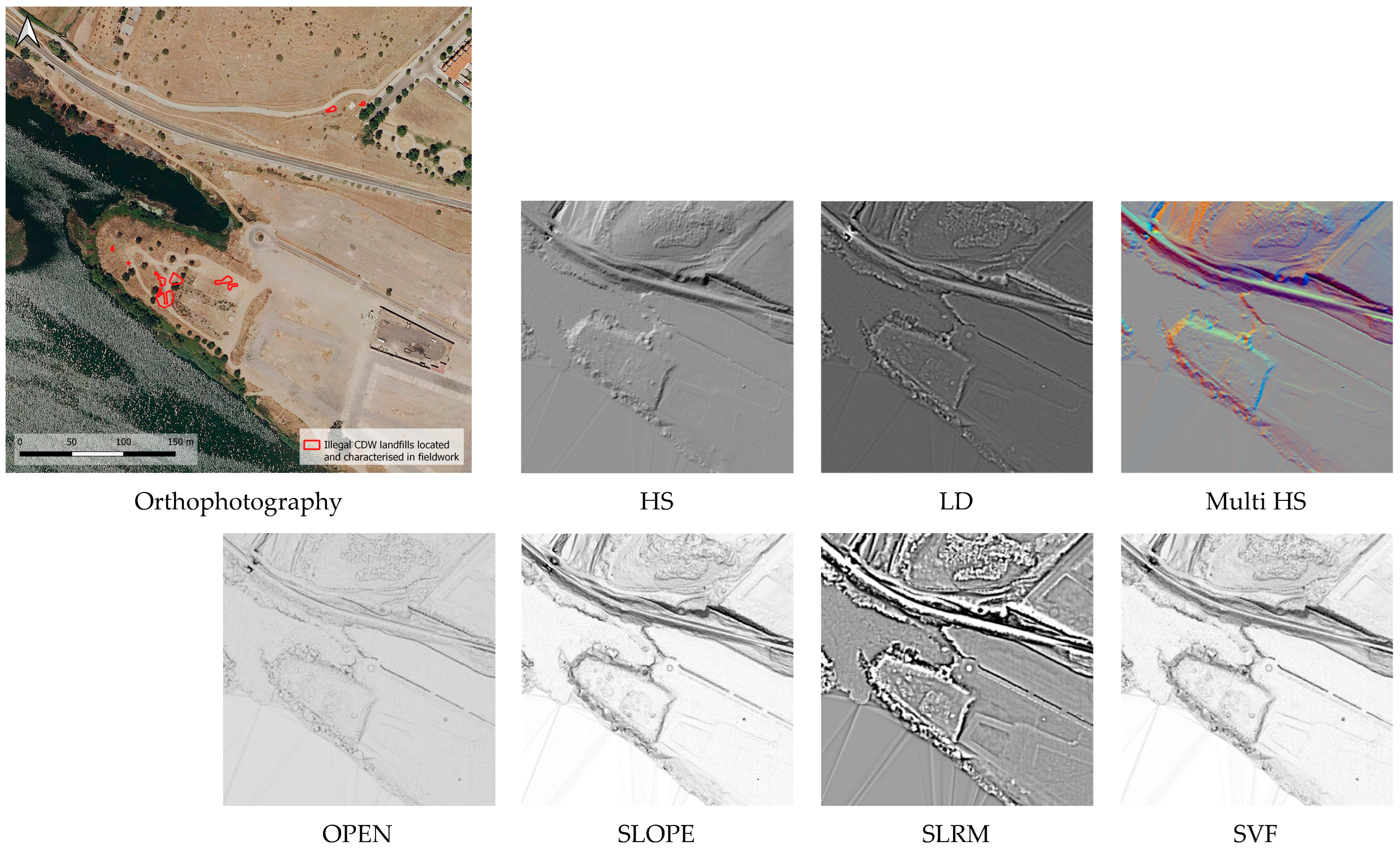Detection of Construction and Demolition Illegal Waste Using Photointerpretation of DEM Models of LiDAR Data
Abstract
:1. Introduction
2. Study Area
- Type A. Plots in nonurban land (three locations). Rural or rustic plots in the middle of which we find illegal CDW. Here we find two types, plots that prior to 2011 were used as illegal waste sites and plots with a natural terrain topography;
- Type B. Connection zones of urban and nonurban land (four locations). For example, residences directly attached to rural plots;
- Type C. Rural pathways located in nonurban land (three locations).
- Type D. Urbanised land (three locations). Nonconsolidated urbanisations in which there are plots that have yet to be developed;
- Type E. Urban land (one location).

3. Materials and Methods
- Analytical hillshading (HS). It allows for observation of the terrain using shades generated by an illumination pattern with a determined direction and elevation (the parameters used were Sun azimuth 315° and Sun elevation angle 35°);
- Hillshading from multiple directions (Multi HS). It is a development of analytical hillshading. This tool calculates the illuminated zones and shades in multiple directions and carries out an RGB representation of the calculated shaded patterns. In this case, we carried out the calculations for 16 directions (the parameters used were 15 directions and Sun elevation angle 35°);
- Slope gradient (SLOPE). It represents the maximum rate of change between each cell and its neighbours. When presented in an inverted greyscale, the more pronounced slopes are darker;
- Simple local relief model (SLRM). This tool eliminates all morphological elements at large scale (hills, valleys, etc.) from the data so that only traits at a large scale remain (used parameters were 16 pixels of radius for the trend assessment);
- Sky-view factor (SVF). It is a proxy for diffuse illumination and measures the proportion of visible sky from a particular point. In an SVF image, elevations are highlighted and appear in clear to white colours, and the depressions are in dark colours (the parameters used were 16 search directions and 10 pixels for the search radium).
- Openness positive (OPEN). The average value of all the zenith angles results in a positive openness, whereas the average value of the nadir results in a negative openness (same parameters as those used for SVF)
- Local dominance (LD). This tool offers good results in the representation of topographic formations with a difference in level, such as a hill or a gap in the terrain (the used parameters were a minimum radius of 16 pixels and a maximum radius of 25 pixels).
- Yes. The orthophotography clearly suggests that what the LD model has marked as CDW is indeed CDW;
- Looks like CDW. When it looks like it could be CDW, but it is not sufficiently clear in the orthophotography;
- Possibly CDW. When we observe that, in relation to the environmental conditions, proximity to construction sites, etc., it is possible that there may be (or may have been at some point) waste;
- No. When there is clearly no CDW.
4. Results and Discussion
4.1. Analysis of the Areas of CDW Localised through Initial Fieldwork






4.2. Applications of the LD Model to the Study Area and Verification of the Results
- “Yes”. There is CDW;
- “No”. Clearly, there is no CDW;
- “Not accessible”. Locations in private plots with restricted access and that we were unable to inspect;
- “Aggregate stockpiling”. Locations where we found temporary stockpiles on the ground.
5. Conclusions
Author Contributions
Funding
Data Availability Statement
Acknowledgments
Conflicts of Interest
References
- Karak, T.; Bhagat, R.M.; Bhattacharyya, P. Municipal Solid Waste Generation, Composition, and Management: The World Scenario. Crit. Rev. Environ. Sci. Technol. 2012, 42, 1509–1630. [Google Scholar] [CrossRef]
- Seeboonruang, U. Geographic Information System–Based Impact Assessment for Illegal Dumping in Borrow Pits in Chachoengsao Province, Thailand. Geol. Soc. Am. Spec. Pap. 2016, 520, 393–405. [Google Scholar]
- Lu, W. Big Data Analytics to Identify Illegal Construction Waste Dumping: A Hong Kong Study. Resour. Conserv. Recycl. 2019, 141, 264–272. [Google Scholar] [CrossRef]
- Junta de Extremadura. PIREX (Plan Integrado de Residuos de Extremadura 2016–2022); Junta de Extremadura: Mérida, Spain, 2022.
- Gobierno de España. Plan Estatal Marco de Residuos 2016–2022 (PEMAR); Gobierno de España: Madrid, Spain, 2022.
- Fernández Jurado, J.A.; González Almendros, C.M.; Sabariego Rivero, S. Vertederos Ilegales; Sección de Málaga del Instituto Andaluz Interuniversitario de Criminología: Málaga, Spain, 1995. [Google Scholar]
- Jordá-Borrell, R.; Ruiz-Rodríguez, F.; Lucendo-Monedero, Á.L. Factor Analysis and Geographic Information System for Determining Probability Areas of Presence of Illegal Landfills. Ecol. Indic. 2014, 37, 151–160. [Google Scholar] [CrossRef]
- Lucendo-Monedero, A.L.; Jordá-Borrell, R.; Ruiz-Rodríguez, F. Predictive Model for Areas with Illegal Landfills Using Logistic Regression. J. Environ. Plan. Manag. 2015, 58, 1309–1326. [Google Scholar] [CrossRef]
- Navarro, J.; Grémillet, D.; Afán, I.; Ramírez, F.; Bouten, W.; Forero, M.G. Feathered Detectives: Real-Time GPS Tracking of Scavenging Gulls Pinpoints Illegal Waste Dumping. PLoS ONE 2016, 11, e159974. [Google Scholar] [CrossRef]
- Quesada-Ruiz, L.; Rodriguez-Galiano, V.; Jordá-Borrell, R. Identifying the Main Physical and Socioeconomic Drivers of Illegal Landfills in the Canary Islands. Waste Manag. Res. 2018, 36, 1049–1060. [Google Scholar] [CrossRef]
- Du, L.; Xu, H.; Zuo, J. Status Quo of Illegal Dumping Research: Way Forward. J. Environ. Manag. 2021, 290, 112601. [Google Scholar] [CrossRef]
- Seror, N.; Portnov, B.A. Identifying Areas under Potential Risk of Illegal Construction and Demolition Waste Dumping Using GIS Tools. Waste Manag. 2018, 75, 22–29. [Google Scholar] [CrossRef] [PubMed]
- Biotto, G.; Silvestri, S.; Gobbo, L.; Furlan, E.; Valenti, S.; Rosselli, R. GIS, Multi-Criteria and Multi-Factor Spatial Analysis for the Probability Assessment of the Existence of Illegal Landfills. Int. J. Geogr. Inf. Sci. 2009, 23, 1233–1244. [Google Scholar] [CrossRef]
- Quesada-Ruiz, L.C.; Rodriguez-Galiano, V.; Jordá-Borrell, R. Characterization and Mapping of Illegal Landfill Potential Occurrence in the Canary Islands. Waste Manag. 2019, 85, 506–518. [Google Scholar] [CrossRef]
- Yadav, S.K. GIS Based Approach for Site Selection in Waste Management. Int. J. Environ. Eng. Manag. 2013, 4, 507–514. [Google Scholar]
- Angelino, C.V.; Focareta, M.; Parrilli, S.; Cicala, L.; Piacquadio, G.; Meoli, G.; Mizio, M.D. A Case Study on the Detection of Illegal Dumps with GIS and Remote Sensing Images. In Proceedings of the Earth Resources and Environmental Remote Sensing/GIS Applications IX, Berlin, Germany, 11–13 September 2018; Michel, U., Schulz, K., Eds.; SPIE: Bellingham, WA, USA, 2018; Volume 10790, p. 107900M. [Google Scholar]
- Torres, R.N.; Fraternali, P. Learning to Identify Illegal Landfills through Scene Classification in Aerial Images. Remote Sens. 2021, 13, 4520. [Google Scholar] [CrossRef]
- Glanville, K.; Chang, H.-C. Remote Sensing Analysis Techniques and Sensor Requirements to Support the Mapping of Illegal Domestic Waste Disposal Sites in Queensland, Australia. Remote Sens. 2015, 7, 13053–13069. [Google Scholar] [CrossRef]
- Manzo, C.; Mei, A.; Fontinovo, G.; Allegrini, A.; Bassani, C. Integrated Remote Sensing for Multi-Temporal Analysis of Anthropic Activities in the South-East of Mt. Vesuvius National Park. J. Afr. Earth Sci. 2016, 122, 63–78. [Google Scholar] [CrossRef]
- Shahab, S.; Anjum, M. Solid Waste Management Scenario in India and Illegal Dump Detection Using Deep Learning: An AI Approach towards the Sustainable Waste Management. Sustainability 2022, 14, 15896. [Google Scholar] [CrossRef]
- Padubidri, C.; Kamilaris, A.; Karatsiolis, S. Accurate Detection of Illegal Dumping Sites Using High Resolution Aerial Photography and Deep Learning. In Proceedings of the 2022 IEEE International Conference on Pervasive Computing and Communications Workshops and other Affiliated Events (PerCom Workshops), Pisa, Italy, 21–25 March 2022; pp. 451–456. [Google Scholar]
- Parrilli, S.; Cicala, L.; VincenzoAngelino, C.; Amitrano, D. Illegal Micro-Dumps Monitoring: Pollution Sources and Targets Detection in Satellite Images with the Scattering Transform. In Proceedings of the 2021 IEEE International Geoscience and Remote Sensing Symposium IGARSS, Brussels, Belgium, 11–16 July 2021; pp. 4892–4895. [Google Scholar]
- Akinina, N.V.; Akinin, M.V.; Taganov, A.I.; Nikiforov, M.B. Methods of Detection in Satellite Images of Illegal Dumps by Using a Method Based on Tree Classifier. In Proceedings of the 2017 6th Mediterranean Conference on Embedded Computing (MECO), Bar, Montenegro, 11–15 June 2017; pp. 1–3. [Google Scholar]
- Notarnicola, C.; Angiulli, M.; Giasi, C.I. Southern Italy Illegal Dumps Detection Based on Spectral Analysis of Remotely Sensed Data and Land-Cover Maps. In Proceedings of the Remote Sensing for Environmental Monitoring, GIS Applications, and Geology III, Barcelona, Spain, 9–11 September 2003; Ehlers, M., Kaufmann, H.J., Michel, U., Eds.; SPIE: Bellingham, WA, USA, 2004; Volume 5239, pp. 483–493. [Google Scholar]
- Bennett, R.; Welham, K.; Hill, R.A.; Ford, A. A Comparison of Visualization Techniques for Models Created from Airborne Laser Scanned Data. Archaeol. Prospect. 2012, 19, 41–48. [Google Scholar] [CrossRef]
- Devereux, B.J.; Amable, G.S.; Crow, P. Visualisation of LiDAR Terrain Models for Archaeological Feature Detection. Antiquity 2008, 82, 470–479. [Google Scholar] [CrossRef]
- Hesse, R. LiDAR-Derived Local Relief Models-a New Tool for Archaeological Prospection. Archaeol. Prospect. 2010, 17, 67–72. [Google Scholar] [CrossRef]
- Guyot, A.; Lennon, M.; Hubert-Moy, L. Objective Comparison of Relief Visualization Techniques with Deep CNN for Archaeology. J. Archaeol. Sci. Rep. 2021, 38, 103027. [Google Scholar] [CrossRef]
- Štular, B.; Eichert, S.; Lozić, E. Airborne LiDAR Point Cloud Processing for Archaeology. Pipeline and QGIS Toolbox. Remote Sens. 2021, 13, 3225. [Google Scholar] [CrossRef]
- Martínez, S.L.; Carlos, J.; Manrique, O.; Rodríguez-cuenca, B.; González, E. Procesado y Distribución de Nubes de Puntos En El Proyecto PNOA-LiDAR. In Proceedings of the XVII Congreso de la Asociación Española de Teledetección, Murcia, Spain, 21–23 October 2015; pp. 3–7. [Google Scholar]
- Kokalj, Ž.; Hesse, R. Airborne Laser Scanning Raster Data Visualization: A Guide to Good Practice; Založba ZRC: Ljubljana, Slovenia, 2017; Volume 14, ISBN 9612549842. [Google Scholar]
- Zakšek, K.; Oštir, K.; Kokalj, Ž. Sky-View Factor as a Relief Visualization Technique. Remote Sens. 2011, 3, 398–415. [Google Scholar] [CrossRef]
- Kokalj, Ž.; Somrak, M. Why Not a Single Image? Combining Visualizations to Facilitate Fieldwork and On-Screen Mapping. Remote Sens. 2019, 11, 747. [Google Scholar] [CrossRef]
- Kokalj, Ž.; Zakšek, K.; Oštir, K.; Pehani, P.; Čotar, K.; Somrak, M.; Kokalj, Ž.; Kokalj, Ž. Relief Visualization Toolbox, Ver. 2.2. 1 Manual. Remote Sens. 2016, 3, 398–415. [Google Scholar]





| HS | LD | Multi HS | OPEN | SLOPE | SLRM | SVF | |
|---|---|---|---|---|---|---|---|
| Type A-1 | 5 | 5 | 5 | 3 | 4 | 4 | 5 |
| Type A-2 | 3 | 5 | 4 | 1 | 1 | 5 | 1 |
| Type B | 4 | 4 | 5 | 1 | 1 | 4 | 1 |
| Type C | 4 | 4 | 5 | 1 | 1 | 5 | 1 |
| Type D | 5 | 5 | 5 | 3 | 4 | 4 | 5 |
| Type E | 5 | 5 | 5 | 3 | 3 | 4 | 3 |
| Average | 4 | 5 | 5 | 2 | 2 | 4 | 3 |
 .
.| HS | LD | Multi HS | OPEN | SLOPE | SLRM | SVF | |
|---|---|---|---|---|---|---|---|
| Type A-1 | 1 | 5 | 1 | 4 | 3 | 3 | 3 |
| Type A-2 | 1 | 3 | 1 | 1 | 1 | 2 | 1 |
| Type B | 1 | 4 | 1 | 2 | 2 | 3 | 1 |
| Type C | 1 | 4 | 1 | 1 | 1 | 2 | 1 |
| Type D | 1 | 4 | 1 | 1 | 1 | 2 | 1 |
| Type E | 1 | 4 | 1 | 1 | 1 | 2 | 1 |
| Average | 1 | 4 | 1 | 2 | 2 | 2 | 1 |
 .
.Disclaimer/Publisher’s Note: The statements, opinions and data contained in all publications are solely those of the individual author(s) and contributor(s) and not of MDPI and/or the editor(s). MDPI and/or the editor(s) disclaim responsibility for any injury to people or property resulting from any ideas, methods, instructions or products referred to in the content. |
© 2023 by the authors. Licensee MDPI, Basel, Switzerland. This article is an open access article distributed under the terms and conditions of the Creative Commons Attribution (CC BY) license (https://creativecommons.org/licenses/by/4.0/).
Share and Cite
Sánchez-Fernández, M.; Arenas-García, L.; Gutiérrez Gallego, J.A. Detection of Construction and Demolition Illegal Waste Using Photointerpretation of DEM Models of LiDAR Data. Land 2023, 12, 2119. https://doi.org/10.3390/land12122119
Sánchez-Fernández M, Arenas-García L, Gutiérrez Gallego JA. Detection of Construction and Demolition Illegal Waste Using Photointerpretation of DEM Models of LiDAR Data. Land. 2023; 12(12):2119. https://doi.org/10.3390/land12122119
Chicago/Turabian StyleSánchez-Fernández, Manuel, Lorea Arenas-García, and José Antonio Gutiérrez Gallego. 2023. "Detection of Construction and Demolition Illegal Waste Using Photointerpretation of DEM Models of LiDAR Data" Land 12, no. 12: 2119. https://doi.org/10.3390/land12122119
APA StyleSánchez-Fernández, M., Arenas-García, L., & Gutiérrez Gallego, J. A. (2023). Detection of Construction and Demolition Illegal Waste Using Photointerpretation of DEM Models of LiDAR Data. Land, 12(12), 2119. https://doi.org/10.3390/land12122119







